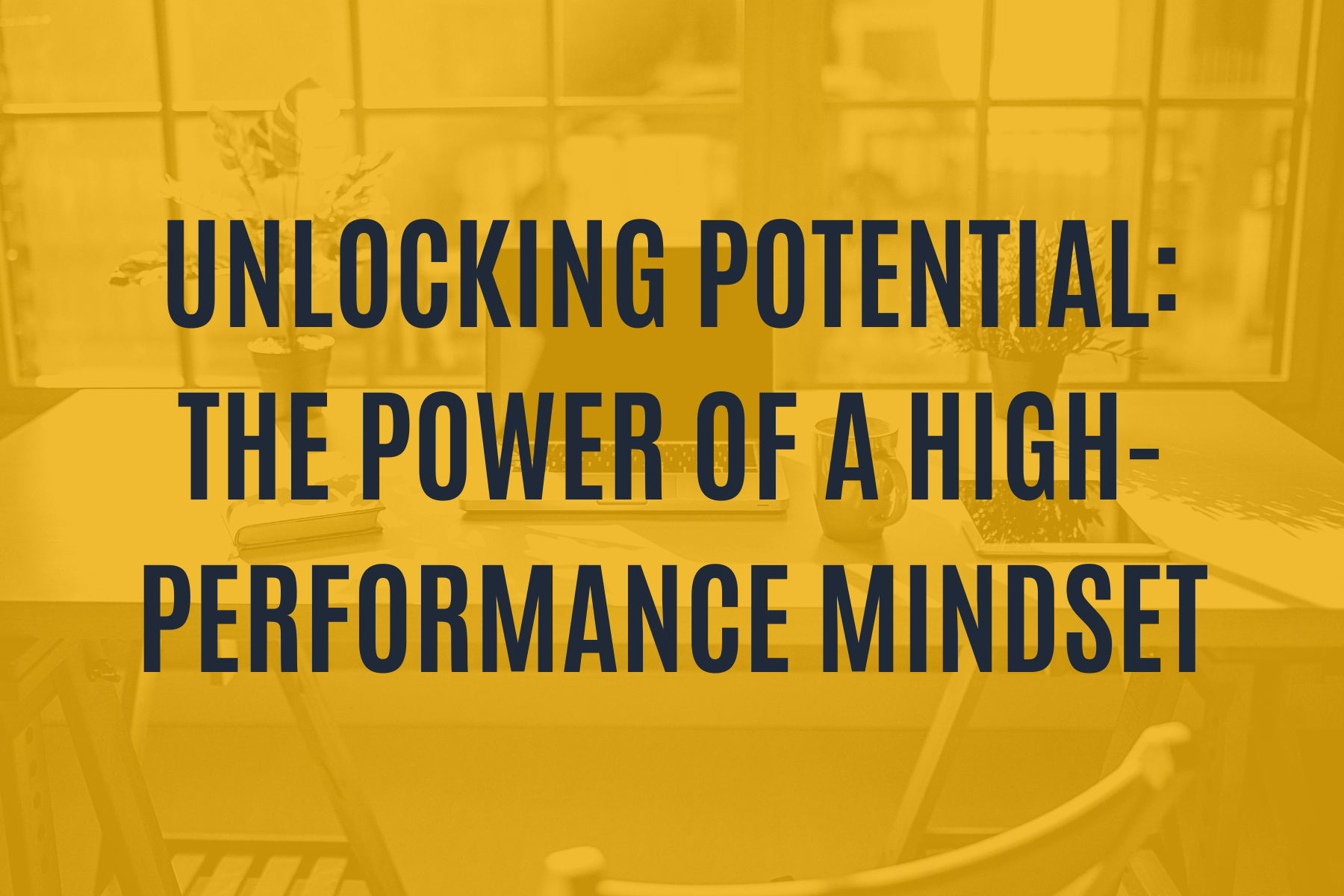Want to receive The Solopreneur’s Shortcut every week? Subscribe here. We’ll send one thought, one tactic, and one time saver straight to your inbox. No fluff, just proven techniques for growing your business.

When I’m leading a webinar there’s one question from the audience that lets me know whether I’m doing a good job or not.
“Is this being recorded?”
Fortunately, that question came up several times while I was leading an event this week, Unlocking Potential: The Power of a High-Performance Mindset.
During this chat, I shared ten tactics and routines that allow me to run my business, stay in shape and be present for my family.
You can watch the full recording here, but I’ve summarized the key points below as well.
A quick scan will tell you this email will take you about six minutes to read. But if you’d like to live a more productive and fulfilling life, I’d say it’s worth the investment.
In fact, these tools are so valuable that I’m already creating a keynote and online course based on the frameworks and associated action items.
I suggest reading through this now, then blocking off sixty minutes to determine how you’ll apply what you’ve learned.
So with that, let’s hop into the ten pillars of high performance.
1. Developing a Personal Philosophy
A personal philosophy is a set of beliefs, values, and principles that guide an individual’s behavior. I explain how you can create yours in this document.
The power of knowing your personal philosophy comes from knowing yourself. When you are clear on what’s important to you and what you stand for, you are equipped to handle life.
My personal philosophy is “Live your legacy.”
People are often concerned with how they’ll be remembered – their legacy – so this encourages me to consistently act in a way now that is aligned with how I want to be remembered later.
2. Focusing on The ONE Thing
In the book, The ONE Thing, the author provides us with a focusing question that can instantly boost our productivity and efficiency.
“What’s the one thing I can do, such that by doing it everything else becomes easier or unnecessary.”
My ONE thing for this quarter was setting up systems that allow my team to sell my services without any involvement from me.
You can also have smaller things that last a short amount of time.
This could include:
- Launching a new course
- Creating a new offer
- Writing a keynote
I usually pick one really big thing for the quarter but then I break it down into smaller goals.
- What’s the one thing this month?
- What’s the one thing this week?
- What’s the one thing today?
- What’s the one thing right now?
Once we have that answer, the author provides more guidance.
“Until your one thing is done, everything else is just a distraction.”
And look, I understand you may have more than ONE thing you need to get done at any given time. That’s ok. The point here is to get extremely focused on what you need to accomplish and block out distractions.
3. Scheduling for success
Based on your personal and professional goals, determine how much time you need to complete your most important tasks. Then block that time off on your calendar.
This exercise helped me realize that I need to spend a minimum of 12 hours per week creating content. And, since I know I’m more creative in the morning, I have that time blocked off earlier in the day.
I also block off time for:
- Engaging on social media
- Listening to podcasts
- Client work
- Exercising
- Meetings
- Reading
With this system in place, you can continuously make meaningful progress by design.
4. Committing to a weekly plan
Once you have time blocked off for your most critical tasks, it’s time to determine exactly what you’ll be doing at those times. Here’s a question to ask yourself at the beginning of every week.
What are the top three things I must get done in order to feel good about the progress I’m making? And, what tasks are associated with these three things?
I’ll share a real example from my weekly planning.
Thing 1:
- Create a new LinkedIn Learns Course
Tasks:
- Write outline
- Design exercises
- Record the course
Since these tasks are aligned with content creation I’d complete them during the time I’ve already allocated.
This process works because you already have the time blocked off, you just need to fill in the details.
5. Leveraging the Pomodoro Technique
Distractions are everywhere, but many of them are self-inflicted. The Pomodoro Technique can help you stay focused while also avoiding burnout.
It’s a time management method based on 25-minute stretches of focused work broken by five-minute breaks.
Here’s the process.
- Identify a task or tasks that you need to complete.
- Set a timer for 25 minutes.
- Work on a task with no distractions.
- When the alarm sounds, take a 5-minute break.
- Repeat the process 3 more times, then take a longer break.
I follow this approach but with one exception; I work for 50 minutes, then take a 10-minute break. And, during this break, I’m usually stretching my legs or grabbing a healthy snack.
If you leverage this technique you’ll be amazed at how much you can accomplish in just a few hours.
Again, that’s why it’s so important to block off that time in advance.
6. Asking yourself “What if?”
You might be wondering how you can block off so many hours for deep work.
Well, what if you told people you’re only available for meetings during a certain time window? This would allow you to protect the time needed for your deep work.
What would happen? From experience, I can tell you they’ll either respect your boundaries or they’ll push back. They won’t tell you to buzz off and never talk to them again.
And sure, there are occasions when you’ll have to be more flexible, but at least you gave yourself the opportunity to commit to the schedule you’ve developed.
Here are a few other examples of how “What if?” can lead to great outcomes.
- What if you pitched that big client you’ve been afraid to contact?
- What if you applied to speak at that big event?
- What if you raised your prices?
If you ask, the answer will be yes or no. If you don’t ask, the answer will definitely be no!
But with this mindset, you can almost look forward to hearing no on a big ask, because you know that means you’re pushing yourself. This builds resilience and resolve.
Plus, when you get a yes, the payoff will be huge.
Let’s take this further.
- What if you started ignoring some of the small things that irritate you?
- What if you weren’t concerned with how others think about you?
- What if you didn’t feel like you had anything to prove?
There’s a freedom and fulfillment that comes from asking “What if?” use it to your advantage.
7. Active Thought Monitoring
Asking yourself “What if?” is a healthy thought to have because it can remove constraints and unlock possibilities. However, we have thousands of thoughts per day. Not all of them are beneficial and some can be to your detriment.
This is why active thought monitoring is so crucial. And, I’ll tell an embarrassing story for context. Last week I caught myself rehashing an argument I had with an insurance agent 20 years ago!
I won’t go into the details because I’ll just get annoyed again but this thought clearly wasn’t aligned with my ONE thing or anything that actually mattered in my life.
So, how did I snap out of it? A simple mental prompt “Is this thought useful or necessary?”
In this case, the thought wasn’t useful or necessary and this prompt helped me get back on track.
Active thought monitoring doesn’t just protect your time, it can improve your mood as well. Your life is shaped by your thoughts.
So if you want to have a better life, think about better stuff.
8. Documenting Your Epic Thoughts
The next question you may have is “What better stuff should I think about?”
It depends on the situation but there are certain thoughts that you need to frontload in order to boost your confidence and improve your attitude, Epic Thoughts.
I first learned about Epic Thoughts from Dr. Michael Gervais, a high-performance psychiatrist. In short, epic thoughts remind you of what you’ve accomplished in the past so you’ll feel more confident in the present moment.
The process is quite simple. Just jot down 10 difficult things you’ve accomplished in the past. Then, mentally review them anytime you’re feeling overwhelmed or need a confidence boost.
This documentation is important because confidence comes from past experiences. And by documenting these experiences you’ll be able to immediately boost your confidence at any moment.
Here are a few of my epic thoughts.
- I ran a Spartan Race
- I got a job at Facebook
- I’m a published author
- I got into business school
- I was a Division 1 college athlete
- I raised four kids during a pandemic
By creating and reviewing your own list you’ll realize how much you’ve already accomplished and how it’s prepared you to take on new challenges going forward.
9. Utilizing Box Breathing and Meditation
While boosting your confidence is often beneficial, sometimes you need a way to quickly reset or relax. Fortunately, you don’t need to wait for your next vacation or spa treatment, you just have to breathe.
Specifically, box breathing.

This is a deep breathing technique that can help you slow down your breathing. It works by distracting your mind as you count to four, calming your nervous system, and decreasing stress in your body.
I aim to do this for eight minutes per day, but you’ll feel the impact in as little as one minute.
Consider doing this – or another form of meditation – when you’re feeling stressed out or need to reset between one task or another.
It’s also beneficial to do this proactively so you can reduce your overall stress and improve focus.
10. Embracing a Deathbed Perspective
I’ve tried several times to create a witty or charismatic opening to this section. I still can’t think of anything so I’m just going to launch into it.
We’re all going to die.
You already know this, but have you leveraged that knowledge to help you live a more meaningful, purposeful life?
Here’s an exercise for you to try out next time you’re feeling unfocused, unmotivated, or unwilling to do what you know must be done.
Imagine it’s several years from now. You’re laying on your deathbed and seeing the present version of yourself who is currently stuck, stagnant or lacking motivation at a specific moment.
Then imagine your future self passionately yelling down at you “don’t waste this opportunity!”
This perspective – which I discovered in the book Tools – can help you realize that time and opportunities are limited, so you must take action now.
Here are a few ways this has helped me over the past week.
- Completing a project
- Admitting I was wrong
- Giving a compliment
- Finishing my workout
- Making an apology
Yes, we’re all going to die, but we still get to choose how we live.
Ok, that was a lot for today. Was this helpful?
Like I said, I’m going to continue building out this content so I’d greatly appreciate your feedback. And if you need help applying what you’ve learned, message me about high-performance coaching.
That’s it for now, enjoy your weekend!

